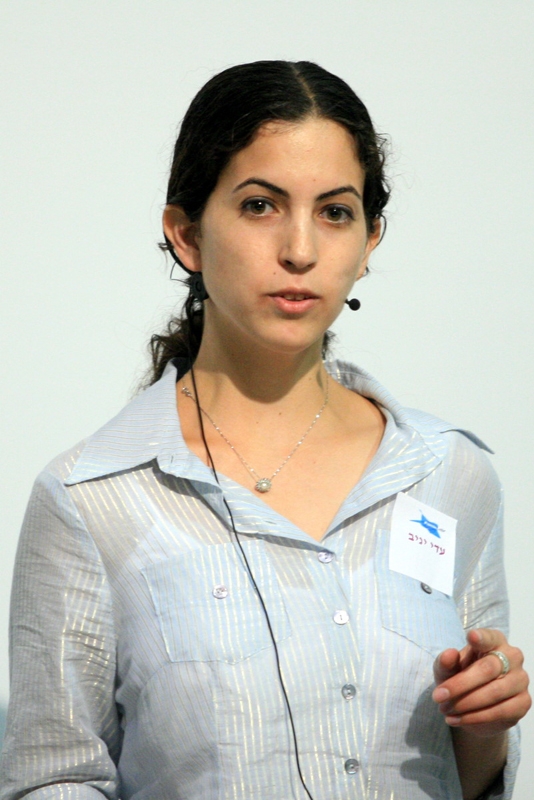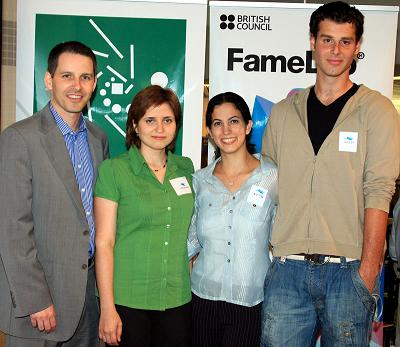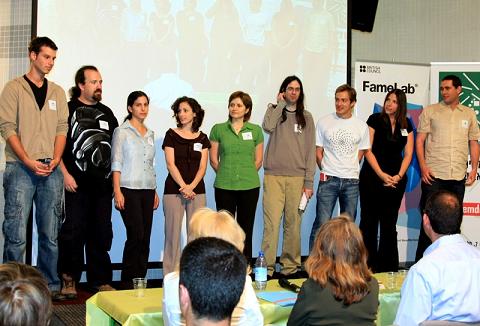A graduate student in biomedicine told how the hormone Vasopressin affects the degree of family functioning traits of the prairie voles compared to the polygamous field voles and won the FeyLab competition and a prize that includes a trip to the Chatham Science Festival, and a laptop

Adi Yaniv, a master's degree student at the Hadassah Ein Kerem Institute of Dentistry at the Hebrew University, is the winner of the "Famelab" competition, a competition in which young scientists are asked to explain complex scientific issues in three minutes to the general public without any aids. The competition, which is organized by the British Council for the second year in collaboration with Hamada - the center for scientific education in Tel Aviv, attracted good young researchers this year as well, including those whose research was published in important journals.
In the final that took place yesterday (Mon), nine researchers who won the first three places in preliminary competitions at the Technion, Hamada in Tel Aviv and the Science Museum in Jerusalem competed, and were judged by Prof. Ehud Gazit from Tel Aviv University, Dr. Liat Jordani, a senior researcher in the field of multiple sclerosis at the Teva company, and Dr. Adi Matan, the British scientific attaché.
Yaniv, the winner of the first prize in the competition, as part of her academic role, researches the subject of salivary gland reconstruction in the laboratory of Prof. Aharon Plamon and, in addition, in her spare time, guides children and youth as part of a science-seeking youth.
"Who among us has not wanted to find the one perfect partner who will only look at you and not at others, take care of the children and know how to change a tire. To know how to do this we can learn a lot from the Arabs. In this rodent species, the males are monogamous, staying with the same female, caring for the offspring together and driving away intruders. On the other hand, in the field warblers, a species close to the prairie warblers, the males flutter about and do not watch over the young. It turns out that everything starts and ends with chemistry. Vasopressin, a hormone produced in the brain and distributed to different areas of the body. When they examined the brain of the prairie vole versus the field vole, they saw that there was a difference in the rate of the hormone. They dripped into the brains of unmarried males of the Arava and Zupersin, and let them live with a single female, and they wanted to stay with her and it didn't help the researchers who tried to match them with the best of the Nevarni. In addition, the researchers took other unmarried breeders, who did not take care of puppies and even hated puppies, and added the hormone to them, and they began to take care of the puppies that were brought to them. so
that the next time you choose a man, pay attention to the hesopressin cheats, this is the smallest and most effective wedding ring in the world."
In response to the judges' question whether it is possible to conclude anything about humans from this, Yaniv said that the hormone is active in humans, but it is used to regulate the water regime in the body. "Its influence is very difficult to isolate among human males. In women, the oxytocin hormone has been studied, which is a hormone secreted during breastfeeding, and which causes the mother to bond with the baby and which is also close, but I have not seen any studies seeking to find out the effect of the hesopressin hormone on humans.
In response to the science site's question about how she came to these studies, Yaniv said: "The main topic I was thinking of talking about is about sex exchange in fish, so I came across vasopressin, I was looking for more materials on this hormone and that's how I came to the research in Navranim. It just seems to me a very interesting topic. I knew vasopressin as a hormone that regulates the water balance and I was very interested to see that it also has a behavioral role. Of course, as a woman, the behavior of males is a very interesting thing."
As a prize winner in the field of science explanation, what can you say about the state of science in Israel?
"I think that science suffers from two problems, one problem is a public relations problem, and the second problem derived from it is an economic problem. As a young researcher, I strongly feel the lack of resources and how we are expected to do research that will compete at an international level in the best universities in the world, and we still conduct such research but with much smaller resources. I would like to hope that this competition will help improve awareness and attitude towards research and that people will understand that this is not something high up in the ivory tower. The results of research is something that affects everyone in their daily lives."
There are arguments between the lecturers and the students regarding this matter, what is the solution?
"The struggle should have been different, because the interest is shared by both the lecturers and the students who will be the lecturers of tomorrow, and today are harmed by the lack of resources. Maybe if there was a joint struggle by all the parties in higher education, something would move."

The second and third places were jointly won by Yaron Fox and Anna Zamansky. Zamansky has a master's degree in computer science at the Technion and is currently a doctoral candidate in the field at Tel Aviv University, dealing with logic and artificial intelligence. She explained about Kurt Godel and the background to his mathematics, when he explained that we could never build a logical system that would prove all mathematical truths. This field is at the seam between the philosophers and the mathematicians and Zamansky accepted that the two sides do not know each other's field well enough to speak the same language. She also told an anecdote about Godel, who because he was afraid of being poisoned, he hardly touched food and died of malnutrition. "He died because he was afraid to die, the biggest paradox of all."
Yaron Fox, 29, assistant professor in the Faculty of Biology at the Technion, skydiving instructor and biker, is engaged in skin research and wound healing using proteins and cancer cell healing. He devoted his short lecture to the genetic repo of the children of the bubble. "22 years ago Ashanti da Silva was born in the USA, but she was born with an acute genetic disease from which the chances of surviving are slim. A defective gene called ADA, which is responsible for the survival of cells in the immune system and without it the cells simply die, is not expressed well enough and any slightest infection could cause her to die. She was a bubble girl. Ashanti took medication to fight the disease and the condition worsened. Dr. Frans Anderson, suggested trying an innovative treatment that had not been tried before. He took white blood cells from Ashanti's body - the cells of the immune system and brought them to the laboratory, multiplied them and inserted a healthy ADA gene into them, injected the cells back into Ashanti and, miraculously, her immune system recovered and she was able to burst the bubble. This is the first trial of gene therapy. They used the gift that nature gave us - viruses. They have developed a skill to penetrate inside the cells and only need to put into them what they want to put into the cell. He used retroviruses from the AIDS family. He has another virtue, he also knows how to insert his hereditary material into the DNA and stay with us forever."
The same topic - gene therapy - was presented by Noa Bachner Hinenzon, a doctoral student in the Faculty of Biomedical Engineering at the Technion, researching the use of ultrasound in heart research: "There is a new healing method called gene therapy - you take normal genes and insert them into cells that have defective genes. One of the results of defective genes is that a certain protein in the body is damaged or missing, and then a hereditary disease occurs. Diabetics are injected with the insulin protein. The proposal was to insert the correct gene into the cells and have our body produce the protein. This thing has already been done, using appropriate viruses, the viruses are small bodies that take their genetic information, insert it into their cells and integrate it into the genes. "
"The question is, is it not dangerous to take and transfer viruses to the body? Changes need to be introduced so that the viruses will not be destructive, will not harm and will not multiply in our body. There is still no solution for diabetics but they give hope to millions of blind people around the world. A successful experiment was done in the UK where they were able to restore sight to four blind people by inserting normal genes into the eye. "
The other participants also presented interesting topics. Alexey Amontes, a 30-year-old PhD student in biochemistry at Tel Aviv University, who studies, among other things, the mechanism of absorption and assimilation of light in plants and who recently published an important scientific article spoke about the golden ratio, the same ratio that causes all the flowers in the world to put out petals not in a random number but in one of the following numbers: 3,5,8,13,21 0.62 (except in cases of mutations) the reason - an efficient arrangement of the primary cells develop on the petals in such a way that more of them will fit into a given volume with an angle ratio between them of XNUMX - the golden ratio. The message is that nature hides a lot of beauty within it, but much more beauty is found in scientific thinking that can be deciphered from the numbers in nature."
Idan Efroni, 33, a doctoral student in plant sciences at the Weizmann Institute, tried to explain the inheritance from the mother - it turns out that plants that have experienced a stress such as radiation pass on a radiation protection feature to their offspring and even after 4 generations they activate it when they experience radiation. This is in contrast to animals and also in contrast to what we thought we knew about genetics.
In animals and humans, the period when the child is in the mother's womb also has a long-term effect, and thus, for example, nutritional deprivation of the mother causes children to develop diseases such as diabetes, heart disease and obesity. The conclusion The mother's lifestyle can be passed on to the offspring, even if the mother always means well.
Nir Lahav, 30, a biophysics student at Bar Ilan sought to explain the concept of entropy by spraying an air purifier, that initially all the smell is inside the purifier, in a state of order, and then it spreads in the room, mixing with atoms of the air. However, it is possible that the atoms of the air purifier return to the box and are compressed in it, and that glass fragments can become a whole glass, but the chances of this are very small.

Viktor Chernov, 29, a rocket scientist at the Faculty of Aeronautical Engineering at the Technion talked about the connection between growing vegetables in space and cancer treatment.
"When you talk about a flight to Mars, you think about big rockets, astronauts, think that it doesn't affect our lives. The example of such an effect is photodynamic therapy - a new treatment for cancer that is based on a substance that has two properties: the first - when exposed to a certain color of light it reacts violently, and the second is that it also resides in cancerous tumors for a longer time. If we inject the substance into the body, wait 72 hours, it will only accumulate in the cancerous tissues, then we can expose them to light. The problem was with the bulb and the light that is projected. We wanted cold light, with a precise color, with a wide beam and it was not available, and here came NASA who wanted to grow lettuce and tomatoes in space and did not intend to cure cancer. It turns out that vegetables use 5-6% of the light, in certain colors. NASA wanted to save energy and decided to provide the plants with light only in the colors relevant to them. NASA took the device and gave it to doctors and told them to change the shape of the lamp or change the bulbs to the wavelengths that suit them. Today it is a treatment used to treat skin cancer, brain cancer and more. Without NASA it would have taken many years."
In conclusion, Chernov says "those who will enjoy the flight to Mars will not only be astronauts who will meet Marvin the Martian, but everyone, those who play tennis, eat hot dishes and also those who need cancer treatment."
Yifat Ofir, a master's degree student in genetics at the Hebrew University, spoke about the subject of fear. "I believe that each of you has a fear of something - spaces, spiders, closed places. You would be willing to pay to be freed from fear. A group of Japanese researchers took the first step towards a world without fears. It turns out that most fears are acquired like fire. But there are innate fears, for example of spoiled food. Study mice - mice's fear of cats. They wanted to check in which sense fear was tested. They took mice that had never seen a cat and even their parents and grandparents had never seen a cat. They showed them a picture of a cat and the mouse did not react with anxiety, nor did it react to the sounds of a cat. But when they were exposed to the smell of a cat they reacted with anxiety. They concluded that the fear of cats is picked up through the sense of smell. They looked for the place in the brain that detects the smell of a cat. They managed to silence the genes and when they put the smell of the cat in the same room the mice did not react with anxiety. Even when the cat was brought in, the mice approached it and smelled it, and it turns out that the cat didn't bother them either, because apparently the reason for cats chasing the mice is their attempt to escape and not the sight or the smell. "
"Most fears come to protect us, the mouse from the cat, the baby from spoiled food. But many of the thrills in our lives originate from fear. The feeling of excitement that you met the love of your heart, the first time you saw your child, maybe it's not so scary to be afraid."
Dr. Eitan Crane, the host of the evening, thanked the British Council at the beginning of the event for the initiative, as well as the organizers of the preliminary competitions -Roey Tsezana who organized the Technion preliminary phase (which won second place last year), and Roni Tseder and Dea Brockman from the Bloomfield Science Museum in Jerusalem. I would like to thank the British Council and its chairman, for the continuous and consistent support for the culture-science program in Hamada. The program draws inspiration from what is done in Britain. I would like to thank the Teva company that is a partner in the project for the second year, the prize givers, the Smart Bait company that gives the first prize, the LPS company that gives the prizes to the other places, Scientific American Israel that gives a prize to all the participants and the Galileo magazine that supported the competition.
Jim Buttery, director of the British Council in Israel: Einstein said he had faith that the principles of the universe were both beautiful and simple. Tonight we see simple, beautiful, and entertaining science here. Think of the evening as an interesting evening and as an evening at the theater.
The director of Hamada Dr. Tahila Ben Gay: "We study according to the curriculum of physics, chemistry and computational science. 27 teachers and 10 staff members are available to the students. The relationship with the community is important to us. We brought the concept of science culture in the community here from Britain. This evening is the climax of the fun part"
The 2007 Faymlav bride, Michal Dekel, also spoke: "A year has passed and I'm still excited. Truly an amazing year that opened a new professional world to me and to all the competitors that allows me to do what I really wanted the most - to take the science and the things I am exposed to and pass these things on to anyone who is not directly exposed to them. "

4 תגובות
Now all that remains is for them to combine gene therapy with insights regarding hormonal effects on monogamy and we will have men who can be trusted. 🙂
Maybe we can watch the lectures on video?
Upload to YouTube for example.
Well done to all the finalists. The lectures were interesting one by one, and as an audience I really enjoyed the way in which the competitors presented the various topics.
And of course, congratulations to Adi Yaniv, Anna Zamansky and Yaron Fox!